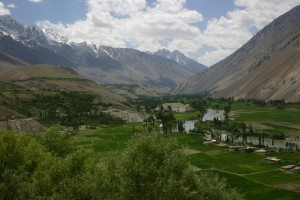Gilgit Baltistan is the most spectacular and fascinating region of Pakistan. It is here that the world’s three famous mountain ranges meet – the Himalayas, the Karakorams and the Hindukush. The whole Northern Pakistan has come to be known as a paradise for mountaineers, climbers, trekkers, hikers and anglers of the most famous “Trout fish”.
In the northern regions of Pakistan, at a stone’s throw from the Amu Darya, is” Bam-e-Dunya” (the roof of the world). This was the name given to the great Pamir plateau, apex of six of the mightiest mountain ranges of the world.
The historic Karakoram pass 5,575 metres, an ancient trading route between Kashmir and Xinjiang, gives its name to the range west of it that forms the watershed between the Indus and the Central Asian deserts. The eastern boundary of the Karakoram is the upper Shyok River from where it extends over 322 km. westwards to the Karumbar river and the Hindukush range. To the north the Shaksgam tributary of the Yarkand River and south by the Indus bound the Karakoram. Here, the Nanga Parbat 8,126 metres massif is the western anchor of the great Himalayan range which stretches in an arc 24,124 km. east to Burma, a boundary and barrier, “the razor’s edge” which for centuries has determined the destiny of the Indian sub-continent.
Such is the setting of Karakoram Range, this remnant of a primeval ice age, “the third pole,” with extensive glacier systems and the greatest concentration of lofty mountains in the world. Some of the largest glaciers outside sub-polar regions flow in the Karakorams. For its sheer mountain grandeur and breath-taking panorama of beauty, few places can match the superb landscape through which the Karakoram Highway snakes. A fantastic and unforgettable spectacle is the passage of the Highway along the Baltura glacier, rated among the worlds seventh largest.
The Khunjerab Pass, which the Highway crosses, and the nearby Mintaka Pass lie astride the fabulous ancient Silk Route that led from Europe to Asia and over which history’s most famous tourists once travelled. These include the Venetian trader Marco Polo after who has been made the wild Marco Polo sheep in the thirteenth century, the Chinese Monk Fe Hien in the fourth century and the Arab historian, Al-Beruni in the eleventh century.
The Siachin glacier is 75 km, the Hispar, (52 km) joints the Biafo at the Hispar La 5,154 metres to form an ice corridor, 116 km. long.The Batura too is 58 km. in length. But the most outstanding of these rivers of ice is the Baltoro (62 km). This mighty glacier fed by some 30 tributaries constitutes a surface area of 1,219 sq. km. Of the fourteen over 8,000 m peaks on earth, four occupy an amphitheatre at the head of Baltoro. There are K-2 (8,611) second only to Everest, Broad Peak (8,047 metres) Gasherbrum-I (8,068 metres), Gasherbrum-II (8,035 metres).

Phander Valley Ghizer
Seen from a distance, the Baltoro appears smooth and beautiful but in fact it is a chaotic tumbling mass of rock and ice, troughs and hillocks and the debris of centuries.
It is a unique remote corner of earth. For here, in a frozen wilderness a crag, cornices and crevasses, raise towering spires of granite, great snowy peaks with fluted icy ridges and pinnacles that pierce the sky.In the Lesser Karakorams there are equally great peaks such as Rakaposhi (7,788 metres), the dominant giant in Hunza valley. Its north face is fantastic precipice – 5,791 metres of plunging snow and ice.
It is a unique remote corner of earth. For here, in a frozen wilderness a crag, cornices and crevasses, raise towering spires of granite, great snowy peaks with fluted icy ridges and pinnacles that pierce the sky.In the Lesser Karakorams there are equally great peaks such as Rakaposhi (7,788 metres), the dominant giant in Hunza valley. Its north face is fantastic precipice – 5,791 metres of plunging snow and ice.
There are scores of over 7,000 m peaks in the Karakoram Range and hundreds of nameless summits below 6,000 metres, mere points on the map. The shapes, forms, sizes, colours provide tremendous contrast, which defy description. K-2, the undisputed monarch of the sky, Broad Peak, massive and ugly, Muztagh Tower, deceptively, sheer. Gasherbrum-II, the “Egyptian Pyramid” that even Cheops would have preferred for a tomb, Chogolisa, the “Bride Peak”, in whose eternal embrace lies Hermann Buhi, the first man to climb Nanga Parbat. The Cathedrals of the Baltoro with their great knife-edge ridges, the sky cleaving monoliths of the Trango Towers and most beautiful of all – the Peak of Perfection – Paiyu, (6,600 metres) first climbed by a Pakistani expedition in 1977.
The Hindukush is also a mountain vastness containing hundreds of peaks, many above 7,000 metres including a Trichmir 7,705 metre that is the highest point of the range

This comment has been removed by a blog administrator.
ReplyDelete